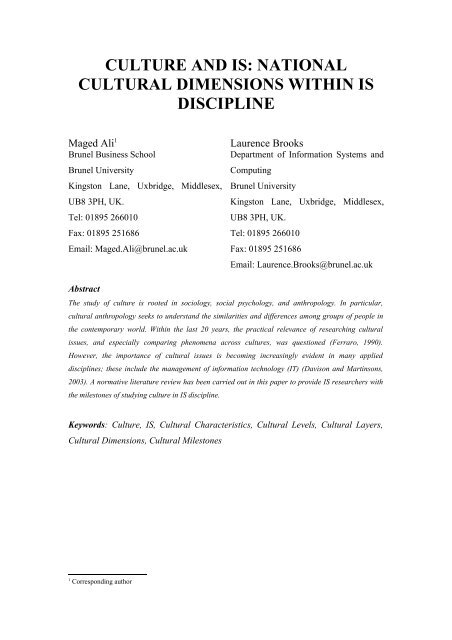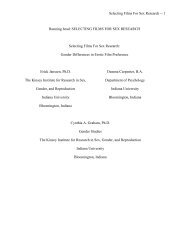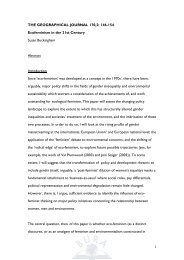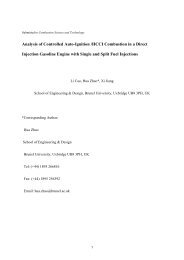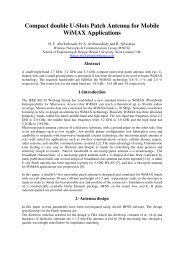Culture and IS: National Cultural Dimensions within - Brunel University
Culture and IS: National Cultural Dimensions within - Brunel University
Culture and IS: National Cultural Dimensions within - Brunel University
Create successful ePaper yourself
Turn your PDF publications into a flip-book with our unique Google optimized e-Paper software.
CULTURE AND <strong>IS</strong>: NATIONAL<br />
CULTURAL DIMENSIONS WITHIN <strong>IS</strong><br />
D<strong>IS</strong>CIPLINE<br />
Maged Ali1 Laurence Brooks<br />
<strong>Brunel</strong> Business School<br />
Department of Information Systems <strong>and</strong><br />
<strong>Brunel</strong> <strong>University</strong><br />
Kingston Lane, Uxbridge, Middlesex,<br />
UB8 3PH, UK.<br />
Tel: 01895 266010<br />
Fax: 01895 251686<br />
Email: Maged.Ali@brunel.ac.uk<br />
Abstract<br />
Computing<br />
<strong>Brunel</strong> <strong>University</strong><br />
Kingston Lane, Uxbridge, Middlesex,<br />
UB8 3PH, UK.<br />
Tel: 01895 266010<br />
Fax: 01895 251686<br />
Email: Laurence.Brooks@brunel.ac.uk<br />
The study of culture is rooted in sociology, social psychology, <strong>and</strong> anthropology. In particular,<br />
cultural anthropology seeks to underst<strong>and</strong> the similarities <strong>and</strong> differences among groups of people in<br />
the contemporary world. Within the last 20 years, the practical relevance of researching cultural<br />
issues, <strong>and</strong> especially comparing phenomena across cultures, was questioned (Ferraro, 1990).<br />
However, the importance of cultural issues is becoming increasingly evident in many applied<br />
disciplines; these include the management of information technology (IT) (Davison <strong>and</strong> Martinsons,<br />
2003). A normative literature review has been carried out in this paper to provide <strong>IS</strong> researchers with<br />
the milestones of studying culture in <strong>IS</strong> discipline.<br />
Keywords: <strong>Culture</strong>, <strong>IS</strong>, <strong>Cultural</strong> Characteristics, <strong>Cultural</strong> Levels, <strong>Cultural</strong> Layers,<br />
<strong>Cultural</strong> <strong>Dimensions</strong>, <strong>Cultural</strong> Milestones<br />
1 Corresponding author
1 INTRODUCTION<br />
Over the past decade there has been increasing interest in the <strong>IS</strong> research literature in<br />
the impact of cultural differences on the development <strong>and</strong> use of information <strong>and</strong><br />
communications technologies. Since many companies are now doing business beyond<br />
their national boundaries – <strong>and</strong> these global activities are facilitated <strong>and</strong> supported to<br />
a large extent by current communications <strong>and</strong> information technologies – it is<br />
important to underst<strong>and</strong> the impact of cultural differences on these activities (Ives &<br />
Jarvenpaa, 1991; Shore & Venkatachalam, 1994; Tractinsky & Jarvenpaa, 1995,<br />
Myers <strong>and</strong> Tan, 2002).<br />
In the following section of this paper, the key concepts of culture will be discussed.<br />
These include definitions of culture, culture characteristics, culture levels, <strong>and</strong> culture<br />
layers. That is followed by a taxonomy of different national cultural dimensions that<br />
has been developed through a normative literature review of <strong>IS</strong> <strong>and</strong> culture research<br />
area.<br />
1.1 <strong>Culture</strong> Definition<br />
A first challenge in conducting research involving culture is arriving at an<br />
underst<strong>and</strong>ing of what culture is, given the myriad of definitions, conceptualizations,<br />
<strong>and</strong> dimensions used to describe this concept (Straub et al. 2002).<br />
Leung et al. (2005) define culture as values, beliefs, norms, <strong>and</strong> behavioural patterns<br />
of a group – people in a society for national culture, staff of an organization for<br />
organizational culture, specific profession for professional culture, etc. Hall, (1976)<br />
has asserted that beliefs <strong>and</strong> values dictate the way people think, behave, solve<br />
problems, make decisions, plan <strong>and</strong> lay out their homes <strong>and</strong> cities, <strong>and</strong> even organize<br />
their economic, political, <strong>and</strong> transportation systems.<br />
Definitions of culture vary from the very inclusive as Herskovitz (1955) defines it as<br />
the human-made part of the environment; to the highly focused as Shweder <strong>and</strong><br />
LeVine, (1984, p.110) who define it as ‘culture is a shared meaning system’.<br />
Groeschl <strong>and</strong> Doherty (2000, p.14) point out that culture is complex <strong>and</strong> very difficult<br />
to define: “<strong>Culture</strong> consists of several elements of which some are implicit <strong>and</strong> others<br />
are explicit. Most often these elements are explained by terms such as behaviour,<br />
values, norms, <strong>and</strong> basic assumptions”. Some researchers proposed culture as tacit or
implicit artefacts such as ideologies, coherent sets of beliefs, basic assumptions,<br />
shared sets of core values, important underst<strong>and</strong>ings, <strong>and</strong> the collective will (Jermier<br />
et al., 1991; Sackmann, 1992; Groeschl <strong>and</strong> Doherty , 2000), others suggest that<br />
culture includes more explicit observable cultural artefacts such as norms <strong>and</strong><br />
practices (Jermier et al., 1991; Groeschl <strong>and</strong> Doherty, 2000; Hofstede 1998), symbols<br />
(Burchell et al. 1980), as well as language, ideology, rituals, myths, <strong>and</strong> ceremony<br />
(Pettigrew 1979; Karahanna et al., 2005).<br />
The socio-cultural system <strong>and</strong> the individual system are two theoretical frameworks<br />
likely to be studied when researchers investigate cultural aspects. The former is<br />
concerned with the institutions, norms, roles, <strong>and</strong> values as they exist outside the<br />
individual, <strong>and</strong> the latter is concerned with the subjective culture as reflected by the<br />
individual’s perception of the elements of the culture system (Dorfman <strong>and</strong> Howell,<br />
1988).<br />
For example, Mead, (1985) defined culture as “shared patterns of behaviour.” This<br />
definition has at least two implications. It implied that culture was a group-level<br />
construct, situated between the personality of individuals <strong>and</strong> the human nature that is<br />
common to all of us. Societies, organizations, <strong>and</strong> professions are among the “groups”<br />
that could be considered to have their own cultures. Also, it implied that the study of<br />
culture involved little more than observing <strong>and</strong> describing behaviour (Davison <strong>and</strong><br />
Martinsons, 2003). Also, Hofstede, (1991, p.5) defines national culture as “the<br />
collective programming of the mind which distinguishes the members of one group or<br />
category of people from another”. He suggests that people share a collective national<br />
character that represents their cultural mental programming. This mental<br />
programming shapes values, beliefs, assumptions, expectations, perceptions <strong>and</strong><br />
behaviour (Myers <strong>and</strong> Tan, 2002). According to Hofstede, (1980) culture is equivalent<br />
to the collective mental programming of a group, tribe, minority, or a nation. It is the<br />
aggregate of individual personality traits.<br />
However, Tri<strong>and</strong>is (1972) defines culture as an individual’s characteristic way of<br />
perceiving the man-made part of one’s environment. It involves the perception of<br />
rules, norms, roles, <strong>and</strong> values, which is influenced by various levels of culture such<br />
as language, gender, race, religion, place of residence, <strong>and</strong> occupation, <strong>and</strong> it<br />
influences interpersonal behaviour. This definition has at least two implications. The<br />
first is that it assumes that by analysing the behaviour of an individual of a society
would not provide a specific identification of the rules, roles, norms <strong>and</strong> values of that<br />
society but rather shows the perception of that individual of the shared cultures he/she<br />
belongs to. The second is that behaviour of an individual would be influenced by the<br />
shared culture which is influenced by different levels of cultures.<br />
Another theme <strong>within</strong> the <strong>IS</strong>/IT discipline is to give an operational perspective to the<br />
culture concept, to link it with the potential influence on <strong>IS</strong>/IT phenomena. Stahl<br />
(2003) defines culture as a determinant of usability of computers. That means that the<br />
culture from which a developer, programmer, or user stems makes a difference<br />
regarding whether he/she is willing or able to use a certain technology.<br />
<strong>Culture</strong> in the sense of a meaning-constituting horizon of the collective life-world<br />
determines the perception <strong>and</strong> use of IT. This may be for the organizational level<br />
where culture can influence whether employees are able <strong>and</strong> willing to use certain<br />
technologies. It may also be true on a social level where people shared perceptions<br />
have some bearing on the use of IT. A national culture that emphasizes sharing <strong>and</strong><br />
the collective, for example, will likely lead to different uses of IT compared with one<br />
that emphasizes the individual <strong>and</strong> competition (Raboy 1997; Riis 1997).<br />
1.2 <strong>Culture</strong> Characteristics<br />
In the review of the many definitions of the concept of culture, researchers conclude<br />
that most authors agree on the following characteristics:<br />
- <strong>Culture</strong> is not a characteristic of individuals, but of the collection of individuals who<br />
share common values, norms, practices, beliefs, ideas etc. these collections may<br />
include family, occupational, regional or national groups which are known as cultural<br />
levels (Olie, 1995; Myers <strong>and</strong> Tan, 2002);<br />
- <strong>Culture</strong> is learned. People learn the culture of a group when they become a member<br />
(Olie, 1995);<br />
- <strong>Culture</strong> has a historical dimension. A particular nation’s culture develops over time<br />
<strong>and</strong> is partly the product of that nation’s history, its demographic <strong>and</strong> economic<br />
development, its geography <strong>and</strong> its ecological environment (Olie, 1995; Myers <strong>and</strong><br />
Tan, 2002; Walsham, 2002);<br />
- <strong>Culture</strong> has different layers. That includes i.e. symbols, heroes, rituals, norms,<br />
practices <strong>and</strong> values (Hofstede, 1991; Olie, 1995; Karahanna et al., 2005).
The first three characteristics of culture are contradicting with the pervious cultural<br />
model of Hofstede (1991). First, culture is not a chrematistic of individual, <strong>and</strong> culture<br />
is learned, this contradicts with Hofstede’s cultural model which assumes there is a<br />
typical cultural mental programming which differentiates one individual from one<br />
society to another society, <strong>and</strong> people born with this cultural mental programming<br />
(Hofstede, 1991). Secondly, Hofstede’s cultural model has provided an index for the<br />
cultural dimensions for the different countries he has conducted <strong>within</strong> his research.<br />
Since his analysis, Hofstede has not updated his index which assumes that culture is a<br />
static rather than dynamic.<br />
1.3 <strong>Cultural</strong> Levels<br />
<strong>National</strong> culture (or cross-cultural) research <strong>and</strong> organizational culture research have<br />
emerged as largely separate research streams <strong>within</strong> <strong>IS</strong>/IT discipline. While the two<br />
streams have experienced little overlap, they both share a focus on defining the values<br />
that distinguish one group from another (Leidner <strong>and</strong> Kayworth, 2006).<br />
<strong>Culture</strong> has been studied <strong>within</strong> <strong>IS</strong> discipline at various levels, including national<br />
(macro level, cross-cultural), organizational, group (sub-culture, professional, special<br />
interest, social class, etc.) <strong>and</strong> individual (micro level, subjective culture) (Tri<strong>and</strong>is,<br />
1972; Hofstede, 1984; Dorfman <strong>and</strong> Howell, 1988; Myers <strong>and</strong> Tan, 2002; McCoy,<br />
2003; Ali <strong>and</strong> Alshawi, 2004a).<br />
<strong>Culture</strong> at a social or national level is the culture shared between people in a society<br />
or a country (Hofstede, 1984). On the other h<strong>and</strong>, culture that is shared between<br />
people working in an organization is called organizational culture (Stahl, 2003). Also,<br />
culture that is shared between people with a similar profession or occupation is called<br />
professional or occupational culture or sub-culture of a specific interest group i.e.,<br />
political party or a social class (Myers <strong>and</strong> Tan, 2002). However, individual culture is<br />
referred to as the subjective culture of an individual which is related to how much an<br />
individual takes from the different cultures that the individual is part of (Dorfman <strong>and</strong><br />
Howell, 1988; Karahanna et al., 2005).<br />
1.4 <strong>National</strong> (Cross-<strong>Cultural</strong>) Level<br />
At a macro level of analysis, national culture is defined as the culture that a society<br />
shares, which is a set of core values, norms, practices etc., which shapes the behaviour<br />
of individuals as well as the whole society (Adler 1997; Bagchi et al., 2003).
Stahl, (2003) defines culture at the macro level as the pure substance of the physical<br />
resources <strong>and</strong> perceptions, of the physical <strong>and</strong> mental techniques, which allow a<br />
society to persist. <strong>Culture</strong> thus consists of fact, artefacts institutions, etc. but its most<br />
important function is that of a reservoir of shared interpretations <strong>and</strong> collective<br />
experiences (Robey & Azevedo 1994).<br />
A few empirical studies have investigated the relationship between national culture<br />
<strong>and</strong> IT adoption, Straub (1994). Straub et al., (1997) have found that the technology<br />
adoption model (TAM) could not predict technology use across all cultures.<br />
Although the national culture construct is inherently complex, it is possible to label<br />
many different taxonomies or dimensions of it. A large body of literature on culture<br />
has identified <strong>and</strong> considered these dimensions. Following a review of some of the<br />
major concepts, a novel taxonomy of different cited national cultural dimensions is<br />
proposed in section 5.<br />
1.5 Organizational Level<br />
Organizational culture could be defined as the culture that staff of an organization<br />
share <strong>and</strong> are influenced by (Adler 1997; Bagchi et al., 2003). Stahl, (2003) defined<br />
corporate culture as commonly shared values, which direct the actions of the<br />
employees towards the common purpose of the enterprise. Corporate or<br />
organizational culture fulfils the same role in an organization that culture fulfils in<br />
society. It defines what is real, what is important, <strong>and</strong> thus how one should act. This<br />
has led to an extensive use of the term as a vehicle of business ethics (Heeg <strong>and</strong><br />
Meyer-Dohm 1994, Grabner-Krauter 2001).<br />
The literature on organizational culture implies that staff of an organization may be<br />
more or less socialized into the organizational culture <strong>and</strong> possibly away from the<br />
national culture (Killmann et al., 1986; Sathe, 1983; Dorfman <strong>and</strong> Howell, 1988).<br />
As with national culture taxonomies, the aim of organizational culture has been to<br />
enable the differentiation of organizations along the lines of dominant values guiding<br />
organizational behaviours (Leidner <strong>and</strong> Kayworth, 2006). But, it is beyond the scope<br />
of this work to identify an exhaustive list of organizational culture theories.
1.6 Group (Sub-<strong>Culture</strong>) Level<br />
Furthermore, since <strong>within</strong> one nation or <strong>within</strong> one organization there can be many<br />
subcultures (e.g., professional associations, political parties, ethic groups),<br />
individuals’ work behaviour may also be influenced by the norms <strong>and</strong> values of these<br />
subcultures (Tri<strong>and</strong>is, 1972).<br />
1.7 Individual Level (Subjective <strong>Culture</strong>)<br />
Dorfman <strong>and</strong> Howell (1988) explored the level of analysis of culture in their<br />
investigation into the effects of national culture on individual behaviour, e.g.<br />
Technology acceptance. They found that subjective culture of an individual<br />
(Karahanna et al., 2005) (which is a mix of different cultures levels that the individual<br />
is part of) may influence the individual behaviour, even in the opposite direction of<br />
the society culture.<br />
1.8 Interaction of <strong>Cultural</strong> Levels<br />
It is theorized that the relative influence of the different levels of culture on individual<br />
behaviour varies depending on the nature of the behaviour under investigation. Thus,<br />
for behaviours that include a strong social component or include terminal <strong>and</strong> moral<br />
values, national cultures might have a predominant effect. For behaviours with a<br />
strong task component or for those involving competence values or practices,<br />
organizational <strong>and</strong> professional cultures may dominate (Karahanna, et al, 2005).<br />
In an organizational setting, national culture is not the only type of culture that<br />
influences managerial <strong>and</strong> work behaviour. Rather, behaviour is influenced by<br />
different levels of culture ranging from the national level, through organizational<br />
levels to the group <strong>and</strong> other sub-cultures level (Hofstede, 1991; Karahanna, et al,<br />
2005).<br />
Straub et al., (2002) based on Social Identity Theory has proposed that these levels<br />
interact. They propose that different layers of culture can influence an individual’s<br />
behaviour <strong>and</strong> that each individual is influenced more by certain layers <strong>and</strong> less by<br />
other layers, depending on the situation <strong>and</strong> their own personal values.<br />
The various levels of culture are laterally related (see Figure 2.1). The levels of<br />
culture are not necessarily hierarchical from the more general (national) to the least<br />
general (group) (Karahanna, et al, 2005). For instance, in the case of multinational
corporations, organizational culture can span national, professional, <strong>and</strong> other sub-<br />
cultures. Furthermore, groups may include members from several organizations,<br />
professions, nations, religions, ethnic backgrounds.<br />
In figure 1, the area labelled individual represents the subjective culture or the<br />
individual level of culture where an individual’s culture is the product of several<br />
levels of culture. Each individual belongs to a specific national culture. Individuals<br />
may also have a religious orientation, a professional degree, belong to a specific<br />
ethnic, linguistic group, <strong>and</strong> so on, which is represented by different sub-culture<br />
groups. Individuals may work in an organization, which is represented by<br />
organizational culture. Some of these cultures may dominate depending on the<br />
situation. The cultures that enfold the individual interact <strong>and</strong> comprise the individual’s<br />
unique culture, eventually influencing the individual’s subsequent actions <strong>and</strong><br />
behaviour (Karahanna, et al, 2005).<br />
<strong>National</strong><br />
Sub-culture 2<br />
Figure 1: Interrelated levels of culture (Adapted from Karahanna et al., 2005)<br />
1.9 <strong>Cultural</strong> Elements (Layers)<br />
Subjective <strong>Culture</strong><br />
or Individual level<br />
of culture<br />
Organizational<br />
Sub-culture 1<br />
Values refer to relationships among abstract categories that are characterized by<br />
strong affective components <strong>and</strong> imply a preference for a certain type of action<br />
(Karahanna, et al, 2005).Values are acquired through lifestyle altering experience,<br />
such as childhood <strong>and</strong> education. They provide a society with fundamental<br />
assumptions about how things are. Once a value is learned, it becomes integrated into<br />
an organized system of values where each value has a relive priority. This value
system is relatively stable in nature but can change over time reflecting changes in<br />
culture (e.g., migration) as well as personal experience. However, values also change<br />
quickly through extreme circumstances e.g. war.<br />
Practices are learned later through socialization at the workplace after an individual’s<br />
values are firmly in place. They provide a society with learned ways of doing things,<br />
such as facts about the world, how it works, <strong>and</strong> cause-effect relationships. Whereas<br />
values are fairly hard to change, practices can be altered (Karahanna, et al, 2005).<br />
A key issue that emerges is the relationship between values <strong>and</strong> practices. Values are<br />
affected by practices during the formative years in which values are starting to form.<br />
Later on in life, practices do not influence values. Conversely, practices are always<br />
evolving. Ideally, practices should reflect values <strong>and</strong> be in sync with them, but that is<br />
not always the case. Karahanna, et al. (2005) suggest that this discontinuity typically<br />
occurs when practices dictated by one level of culture (e.g., organizational) are at<br />
odds with values comprising another level of culture (e.g., national). Practices are<br />
much more related to current environmental conditions.<br />
<strong>National</strong> cultural differences are composed primarily of differences in values <strong>and</strong> to a<br />
lesser extent, of differences in practices (Hofstede, 1991). Figure 2 (adapted from<br />
Karahanna et al., 2005) illustrates the relative importance of values <strong>and</strong> practices at<br />
various levels of culture. Values are more important than practices in the higher level<br />
cultures (i.e., national), <strong>and</strong> practices <strong>and</strong> norms dominate the lower level of cultures<br />
(i.e., group).<br />
<strong>Cultural</strong> Levels <strong>Cultural</strong> Layers<br />
<strong>National</strong><br />
Organizational<br />
Group<br />
Values<br />
Norms<br />
Practices<br />
Norms<br />
Figure 2: <strong>Cultural</strong> Levels <strong>and</strong> <strong>Cultural</strong> Layers (Adapted Karahanna et al., 2005)
1.10 <strong>National</strong> <strong>Cultural</strong> Values <strong>Dimensions</strong><br />
Schein (1985) argues that values are more easily studied than basic assumptions,<br />
which are invisible <strong>and</strong> preconscious <strong>and</strong> therefore not easily identified, as well as<br />
cultural artefacts (technology, art, visible <strong>and</strong> audible behaviours) that, while being<br />
more visible, are not easily decipherable.<br />
It is not surprising, then, that the vast majority of theories that conceptualize culture<br />
do so in terms of reference group value orientations such as value dimensions of<br />
national culture (Hofstede, 1980).<br />
Even while the focus has largely been on values, there is a tight linkage between<br />
cultural values <strong>and</strong> the subsequent behaviours <strong>and</strong> actions of social groups (Posner<br />
<strong>and</strong> Munson 1979). In this sense, values can be seen as a set of social norms that<br />
define the rules or context for social interaction through which people act <strong>and</strong><br />
communicate (Delong <strong>and</strong> Fahey 2000; Keesing 1974; Nadler <strong>and</strong> Tushman 1988).<br />
These social norms have an impact on subsequent behaviours of firm members<br />
through acting as a means of social control that sets the expectations <strong>and</strong> boundaries<br />
of appropriate behaviours for members (O’Reilly <strong>and</strong> Chatman 1996). Thus, the study<br />
of organizational values may be particularly useful in explaining certain behaviours<br />
with respect to how social groups interact with <strong>and</strong> apply IT in organizational<br />
contexts (Leidner, <strong>and</strong> Kayworth, 2006).<br />
There is general acceptance that the value-based framework for measuring cultures<br />
has been helpful in deciphering cultures (Leung et al., 2002; Leung et al., 2005).<br />
Although the construct is inherently complex, it is possible to label many different<br />
aspects or dimensions of it. A summary of the cultural dimensions which have been<br />
cited <strong>within</strong> the <strong>IS</strong> discipline has been developed <strong>and</strong> is presented in Table 1. The<br />
researcher develops the summery of cultural dimensions through a normative<br />
literature review <strong>within</strong> ‘<strong>IS</strong> <strong>and</strong> <strong>Culture</strong>’ research area. This constrain has limited the<br />
previous literature to be considered in this thesis. The researcher categorized the<br />
different cultural vales dimensions when these dimensions have the same meanings.<br />
<strong>Culture</strong> Dimension Definition<br />
Uncertainty Avoidance (Hofstede, 1980, 1983,<br />
1991)<br />
Free Will vs. Determinism (Kluckhohn <strong>and</strong><br />
Strodbeck, 1961)<br />
High Trust vs. Low Trust (Fukuyama, 1995)<br />
Degree to which people in a country prefer structured over<br />
unstructured situations: from relatively flexible to extremely<br />
rigid. Also, this refers to the degree that people in a society<br />
bear risk, from risk averse to risk taker. Also, the degree that<br />
people in a society trust <strong>and</strong> feeling comfortable with<br />
dealing with the unknown.
Power Distance (Hofstede, 1980, 1983, 1991)<br />
Hierarchy vs. Egalitarian (Schwartz, 1994)<br />
Authority Ranking Relationships (Fiske, 1992)<br />
Equality – Hierarchy (Hampden-Turner <strong>and</strong><br />
Trompenaars, 1994)<br />
Masculinity/femininity (Hofstede, 1980, 1983,<br />
1991)<br />
Degree of inequality among people, which the population of<br />
a country considers as normal: from relatively equal to<br />
extremely unequal.<br />
Degree to which “masculine” values like assertiveness,<br />
performance, success <strong>and</strong> competition prevail over<br />
“feminine” values like the quality of life, maintaining warm<br />
personal relationships, service, caring, <strong>and</strong> solidarity: from<br />
tender to tough.<br />
Individualism/Collectivism (Hofstede, 1980 Degree to which people in a country have learned to act as<br />
1983, 1991)<br />
individuals rather than as members of cohesive groups: from<br />
Individualism/Communitarianism<br />
collectivist to individualist.<br />
(Trompenaars, 1993)<br />
Wide sharing vs. Non sharing (Newman et al.,<br />
1977)<br />
Communal Sharing Relationships (Fiske, 1992)<br />
Idiocentric – Allocentric (Tri<strong>and</strong>is, 1995)<br />
Confucian Dynamism (Long-term orientation<br />
vs. short term orientation) (Hofstede <strong>and</strong> Bond,<br />
1988; Hofstede, 1994)<br />
Long term orientation cultures value virtues oriented toward<br />
future rewards, in particular perseverance <strong>and</strong> thrift. Short<br />
term orientation st<strong>and</strong>s for the fostering of virtues related to<br />
the past <strong>and</strong> present, in particular respect for tradition,<br />
preservation of ‘face’ <strong>and</strong> fulfilling social obligations.<br />
Universalism-Particularism (Trompenaars, Degree to which people in a country compare generalist<br />
1993; Hampden-Turner <strong>and</strong> Trompenaars, 1994) rules about what is right with more situation-specific<br />
relationship obligations <strong>and</strong> unique circumstances<br />
Neutral vs. Emotional Relationship Orientations Degree to which people in a country compare ‘objective’<br />
(Trompenaars, 1993)<br />
<strong>and</strong> ‘detached’ interactions with interactions where<br />
Analyzing vs. Integrating (Hampden-Turner <strong>and</strong> emotions is more readily expressed.<br />
Trompenaars, 1994)<br />
Objective- Emotional (Newman et al., 1977)<br />
Rationalism- Humanism (Lessem <strong>and</strong> Neubauer,<br />
1994)<br />
Specific vs. Diffuse Orientations (Trompenaars, Degree to which people in a country have been involved in a<br />
1993)<br />
business relationships with in which private <strong>and</strong> work<br />
Inner-directed vs. outer-directed (Hampden- encounters are demarcated <strong>and</strong> ‘segregated-out’<br />
Turner <strong>and</strong> Trompenaars, 1994)<br />
Achievement vs. Ascription (Trompenaars,<br />
1993)<br />
Achieved status vs. Ascribed Status (Hampden-<br />
Turner <strong>and</strong> Trompenaars, 1994)<br />
Merit based vs. Relationship based (Newman et<br />
al., 1977)<br />
Equality Matching Relationships (Fiske, 1992)<br />
Conservatism vs. Affective/intellectual<br />
autonomy (Schwartz, 1994)<br />
Improvement vs. maintaining status quo<br />
(Newman et al., 1977)<br />
Harmony vs. Mastery (Schwartz, 1994)<br />
Degree to which people in a country compare cultural<br />
groups which make their judgments of others on actual<br />
individual accomplishments (achievement oriented<br />
societies) with those where a person is ascribed status on<br />
grounds of birth, group membership or similar criteria.<br />
Degree to which people in a country emphasise maintenance<br />
of status quo (Conservatism), or emphasis creativity or<br />
affective autonomy emphasis the desire for pleasure <strong>and</strong> an<br />
exciting life.<br />
Degree to which people in a country concerned with<br />
overcoming obstacles in the social environment (Mastery)<br />
vs. concern beliefs about unity with nature <strong>and</strong> fitting<br />
High context vs. Low context (Hall, 1960, 1976;<br />
Hall & Hall, 1990)<br />
harmoniously into the environment.<br />
Market Pricing Relationships (Fiske, 1992) Degree to which people in a country think in terms of prices<br />
Accumulation of Wealth vs. ‘Just Enough’ <strong>and</strong> investment.<br />
(Kluckhohn <strong>and</strong> Strodbeck, 1961)<br />
Monochronic vs. Polychronic (Lewis, 1992) Attitudes toward use of time in performing tasks either<br />
Time as sequence vs. time as synchronization focusing on issues one at a time (monochronic) or<br />
(Hampden-Turner <strong>and</strong> Trompenaars, 1994) performing of activities in parallel (polychronic)
Monomorphic – Polymorphic (Bottger, et al., A population in which virtually all individuals have the<br />
1985)<br />
same genotype at a locus.<br />
Paragmatism – Idealism (Lessem <strong>and</strong> Neubauer, Pragmatism is characterized by the insistence on<br />
1994)<br />
consequences, utility <strong>and</strong> practicality as vital components of<br />
truth. The pragmatists' world is pluralistic, attentive to<br />
context, relativistic about truth <strong>and</strong> value, devoid of<br />
metaphysical concerns except as they have practical<br />
consequences<br />
Table 1: A Summary of Cited <strong>National</strong> <strong>Culture</strong> Values <strong>Dimensions</strong> in <strong>IS</strong> Domain<br />
1 Conclusion<br />
In this paper, the researcher have provided a platform for <strong>IS</strong> researchers who are<br />
willing to study culture <strong>within</strong> <strong>IS</strong> discipline. <strong>Culture</strong> definitions, characteristics,<br />
levels, layers, <strong>and</strong> dimensions have been discussed through covering the literature<br />
review of culture <strong>and</strong> <strong>IS</strong>. In future research, the authors are going to validate the<br />
proposed cultural dimensions framework provided in this paper through empirical<br />
research <strong>within</strong> culture <strong>and</strong> <strong>IS</strong>. Also, predefined archetypes cultural dimensions are<br />
going to be testified with other approaches to study culture.<br />
References<br />
Adler, N. J., 1997. International <strong>Dimensions</strong> of Organizational Behaviour, 3rd edn.<br />
Cincinnati, OH: Shout-Western College Publishing.<br />
Ali, M. <strong>and</strong> Alshawi, S. 2004a. ‘A <strong>Cultural</strong> Approach to Study Customer Relationship<br />
Management (CRM) Systems’, Proceedings of C<strong>IS</strong>TM 2004, Alex<strong>and</strong>ria, Egypt [CD<br />
Proceedings].<br />
Bagchi, K., Cerveny, R., Paul, H., <strong>and</strong> Petserson, M. 2003. ‘The Influence of <strong>National</strong> <strong>Culture</strong><br />
in Information Technology Product Adoption’, Proceedings of the Ninth Americas<br />
Conference on Information Systems (AMC<strong>IS</strong>) 2003, Tampa, USA (CD Proceedings).<br />
Bottger, P., Hallein, I., <strong>and</strong> Yetton, P. 1985. ‘A cross-national study of leadership:<br />
Participation as a function of problem structure <strong>and</strong> leader power’, Journal of Management<br />
Studies, 22(4): 358-368.<br />
Burchell, S., Clubb, C., Hopwood, A. G., Hughes, J., <strong>and</strong> Nahapiet, J. 1980. ‘The Roles of<br />
Accounting in Organizations <strong>and</strong> Society’, Accounting, Organizations, <strong>and</strong> Society, 5(1): 5-<br />
27.<br />
Davison, R. <strong>and</strong> Martinsons, M. 2003. ‘Guest Editorial, <strong>Cultural</strong> Issues <strong>and</strong> IT Management:<br />
Past <strong>and</strong> Present’, IEEE Transactions On Engineering Management, 50(1): 3-7.<br />
Delong, D. W., <strong>and</strong> Fahey, L. 2000. ‘Diagnosing <strong>Cultural</strong> Barriers to Knowledge<br />
Management’, Academy of Management Executive, 14(4): 113-127.<br />
Dorfman, W. P. <strong>and</strong> J. P. Howell 1988. ‘<strong>Dimensions</strong> of <strong>National</strong> <strong>Culture</strong> <strong>and</strong> Effective<br />
Leadership Patterns: Hofstede Revisited’, Advances in International Comparative<br />
Management, 3, 127-150.<br />
Dorfman, W. P. <strong>and</strong> J. P. Howell 1988. ‘<strong>Dimensions</strong> of <strong>National</strong> <strong>Culture</strong> <strong>and</strong> Effective<br />
Leadership Patterns: Hofstede Revisited’, Advances in International Comparative<br />
Management, 3, 127-150.<br />
Fiske, A. P. 1992. ‘The four elementary forms of sociality: Framework for a unified theory of<br />
social relations’, in Goodwin, R. (eds), Personal Relationships Across <strong>Culture</strong>s, (pp. 22-36)<br />
Routledge, London.<br />
Fukuyama, F. 1995. Trust: The Social Virtues <strong>and</strong> the Creation of Prosperity, London:<br />
Hamish Hamilton.
Grabner-Kräuter, S. <strong>and</strong> Kaluscha, E. A. 2003. ‘Empirical research in on-line trust: a review<br />
<strong>and</strong> critical assessment’, International Journal of Human-Computer Studies, 58(6): 783-812.<br />
Groeschl, S. & Doherty, L. 2000. ‘Conceptualizing culture’, Cross <strong>Cultural</strong> Management - An<br />
International Journal, 7(4): 12-17.<br />
Hall, E. T. 1960. ‘The silent language in overseas business’, Harvard Business Review, May-<br />
June. 38(3).<br />
Hall, E. T. 1976. Beyond <strong>Culture</strong>, New York: Anchor Press.<br />
Hall, E. T., <strong>and</strong> Hall, M. R. 1990. Underst<strong>and</strong>ing <strong>Cultural</strong> Differences, Yarmouth, Maine:<br />
Intercultural Press.<br />
Hampden-Turner, C., <strong>and</strong> Trompenaars, F. 1994. The Seven <strong>Culture</strong>s of Capitalism, London:<br />
Piatkus.<br />
Heeg, F.J. <strong>and</strong> Meyer-Dohm, P. (eds.) 1994. Methods for Organisation Design <strong>and</strong> Personnel<br />
Development (in German). Carl Han-ser Verlag, Munchen, Germany.<br />
Herskovitz, M.J. 1955. <strong>Cultural</strong> Anthropology, Knopf: New York.<br />
Hofstede, G. 1980. <strong>Culture</strong>’s Consequences: International Differences in Work-Related<br />
Values, Beverly Hills, California: SAGE Publications.<br />
Hofstede, G. 1983. ‘<strong>National</strong> culture in four dimensions’. International Studies of<br />
Management <strong>and</strong> Organization, 13(2): 46-74.<br />
Hofstede, G. 1984. ‘<strong>Culture</strong> Consequences’, Newbury Park, CA: Sage.<br />
Hofstede, G. 1991. <strong>Culture</strong>s <strong>and</strong> Organizations: Software of the Mind, McGraw-Hill, New<br />
York.<br />
Hofstede, G. 1998. ‘Identifying Organizational Subcultures: An Empirical Approach’, Journal<br />
of Management Studies, 35(1): 1-12.<br />
Hofstede, G. <strong>and</strong> Bond, M.H. 1988. ‘The Confucius connection: from cultural roots to<br />
economic growth’, Organization Dynamics, 16(4): 5-21.<br />
Ives, B. <strong>and</strong> Jarvenpaa, S. L. 1991. ‘Applications of global information technology: key issues<br />
for management’, M<strong>IS</strong> Quarterly, 15(1): 33–49.<br />
Jermier, J. M. Slocum, J. W. Fry, L. W. <strong>and</strong> Gaines, J. 1991. ‘Organizational Subcultures in a<br />
Soft Bureaucracy: Resistance Behind the Myth <strong>and</strong> Façade of an Official <strong>Culture</strong>’,<br />
Organization Science, 2(2): 170-194.<br />
Karahanna, E., Evaristo, J., <strong>and</strong> Srite, M. 2005. ‘Levels of <strong>Culture</strong> <strong>and</strong> Individual Behaviour:<br />
An Integrative Perspective’, Journal of Global Information Management, 13(2): 1-20.<br />
Keesing, R. M. 1974. ‘Theories of <strong>Culture</strong>’, Annual Review of Anthropology, 3, 73-97.<br />
Killmann, R. H. Saxton, M. J. <strong>and</strong> Serpa, R. 1986. ‘Issues in underst<strong>and</strong>ing <strong>and</strong> changing<br />
culture’, California Management Review, 29(2): 89-96.<br />
Kluckhohn, F. R. <strong>and</strong> Strodbeck, F. L. 1961. Variations in Value Orientations, Evanston, IL.:<br />
Row Peterson.<br />
Leidner, D. <strong>and</strong> Kayworth, T. 2006. ‘Review: A Review Of <strong>Culture</strong> In Information Systems<br />
Research: Toward A Theory Of Information Technology <strong>Culture</strong> Conflict’, M<strong>IS</strong> Quarterly,<br />
30(2): 357-399.<br />
Lessem, R., <strong>and</strong> Neubauer, F. 1994. European Management Systems, London: McGraw-Hill.<br />
Leung, K. Bhagat, R.S. Buchan, N.R. Erez, M. <strong>and</strong> Gibson, C.B. 2005. ‘<strong>Culture</strong> <strong>and</strong><br />
international business: recent advances <strong>and</strong> their implications for future research’, Journal of<br />
International Business Studies, 36(4): 357–378.<br />
Leung, K. Bond, M.H. Reimel de Carrasquel, S. Munoz, C. Hern<strong>and</strong>ez, M. Murakami, F.<br />
Yamaguchi, S. Bierbrauer, G. <strong>and</strong> Singelis, T.M. 2002. ‘Social axioms: the search for<br />
universal dimensions of general beliefs about how the world functions’, Journal of Cross-<br />
<strong>Cultural</strong> Psychology, 33(3):286–302.<br />
McCoy, S. 2003. ‘Integrating <strong>National</strong> <strong>Cultural</strong> Into Individual <strong>IS</strong> Adoption Research: The<br />
Need for Individual Level Measures’, Proceedings of the Ninth Americas Conference on<br />
Information Systems (AMC<strong>IS</strong>) 2003, Tampa, Florida, USA (CD Proceedings).<br />
Mead, 1985<br />
Myers, M. D. <strong>and</strong> Tan, F. 2002. ‘Beyond Models of <strong>National</strong> <strong>Culture</strong> in Information Systems<br />
Research’, Journal of Global Information Management, 10(1): 24-32.<br />
Nadler, D. <strong>and</strong> Tushman, M. 1988. Strategic Organization Design, Scott Foresman <strong>and</strong>
Company, Glenview, IL.<br />
Newman, W. H. Summer, C. E. <strong>and</strong> Warren, E. K. 1977. The Process of Management,<br />
Englewood Cliffs, NJ: Prentice Hall.<br />
O’Reilly, C. A. <strong>and</strong> Chatman, J. A. 1996. ‘<strong>Culture</strong> as Social Control: Corporations, Cults, <strong>and</strong><br />
Commitment’, Research in Organizational Behaviour, 18, 157-200.<br />
Olie, R. 1995. ‘The ‘culture’ factor in personnel <strong>and</strong> organization policies’, In: Harzing, AW.,<br />
<strong>and</strong> Ruysseveldt, J. V. (eds), International Human Resource Management, Sage Publications.<br />
London. 124-143.<br />
Pettigrew, A. M. 1979. ‘On Studying Organizational <strong>Culture</strong>s’, Administrative Science<br />
Quarterly, 24(4): 570-581<br />
Posner, B. Z., <strong>and</strong> Munson, J. M. 1979. ‘The Importance of Values in Underst<strong>and</strong>ing<br />
Organizational Behaviour’, Human Resource Management, 18(3): 9-14.<br />
Raboy, M. 1997. ‘<strong>Cultural</strong> Sovereignty, Public Participation, <strong>and</strong> Democratization of the<br />
Public Sphere: the Canadian Debate on the New Information Infrastructure’, <strong>National</strong><br />
Information Infrastructure Initiatives Vision <strong>and</strong> Policy Design, Cambridge, Massachusetts<br />
<strong>and</strong> London, Engl<strong>and</strong>, MIT Press: 190-216.<br />
Riis, M. A. 1997. ‘The Information Welfare Society: An Assessment of Danish Governmental<br />
Initiatives Preparing for the Information Age’, <strong>National</strong> Information Infrastructure Initiatives<br />
Vision <strong>and</strong> Policy Design, Cambridge, Massachusetts, <strong>and</strong> London Engl<strong>and</strong>, MIT Press: 424-<br />
456.<br />
Robey, D. & Azevedo, A. 1994. ‘<strong>Cultural</strong> Analysis of the Organizational Consequences of<br />
Information Technology’, Accounting, Management <strong>and</strong> Information Technologies, (4)1: 23-<br />
37.<br />
Sathe, V. 1983. ‘Some action implications of corporate culture: A manager’s guide to action’,<br />
Organizational Dynamics, (Autumn), 5-23.<br />
Schein, E. H. 1985. ‘Organizational <strong>Culture</strong> <strong>and</strong> Leadership’, Jossey-Bass, San Francisco,<br />
CA.<br />
Schwartz, S. 1994. ‘Beyond Individualism-Collectivism: New <strong>Cultural</strong> dimensions of values’,<br />
in Goodwin, R. (eds), Personal Relationships Across <strong>Culture</strong>s, Routledge, London: 22-36<br />
Shore, B., <strong>and</strong> Venkatachalam, A. R. 1994. ‘Prototyping: A metaphor for cross-cultural<br />
transfer <strong>and</strong> implementation of <strong>IS</strong> applications’, Information & Management, 27, 175-184.<br />
Shweder, R.A <strong>and</strong> Levine, R.A. 1984. <strong>Culture</strong> Theory: Essays on Mind, Self <strong>and</strong> Emotion,<br />
Cambridge <strong>University</strong> Press: New York.<br />
Stahl, B. C. 2003. ‘<strong>Cultural</strong> Universality Versus Particularity In CMC’, Proceedings of the<br />
Ninth Americas Conference on Information Systems (AMC<strong>IS</strong>) 2003, USA (CD Proceeding).<br />
Straub, D. 1994. ‘The Effect of <strong>Culture</strong> on IT Diffusion: E-Mail <strong>and</strong> Fax in Japan <strong>and</strong> the<br />
U.S’, Information Systems Research, 5(1): 23-47.<br />
Straub, D. Loch, K. Evaristo, R. Karahanna, E. <strong>and</strong> Srite, M. 2002. ‘Toward a Theory-Based<br />
Measurement of <strong>Culture</strong>’, Journal of Global Information Management, 10(1): 13-23.<br />
Straub, D., M. Keil, <strong>and</strong> Brenner, W. 1997. ‘Testing the technology acceptance model across<br />
cultures: A three country study’, Information & Management Journal, 33(1): 1-11.<br />
Tractinsky, N. <strong>and</strong> Jarvenpaa, S. L. 1995. ‘Information systems design decisions in a global<br />
versus domestic context’, M<strong>IS</strong> Quarterly, 16(4): 507-534.<br />
Tri<strong>and</strong>is, H. C. 1995. ‘Individualism & Collectivism’, Boulder, Colorado: Westview Press.<br />
Tri<strong>and</strong>is, H. C., 1972. The Analysis Of Subjective <strong>Culture</strong>, New York: John Wiley & Sons.<br />
Trompenaars, F. 1993. Riding the Waves of <strong>Culture</strong>, London: Nicholas Brealey.<br />
Walsham, G. 2002. ‘Cross-<strong>Cultural</strong> Software Production <strong>and</strong> Use: A Structurational<br />
Analysis’, M<strong>IS</strong> Quarterly, 26(4): 359-380.


